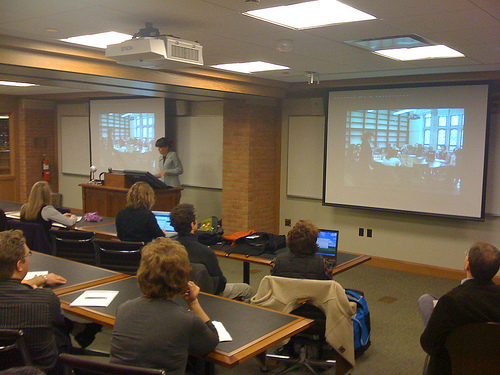
Image Credit:
As described in more detail here, students in my “Literature and Biology” course participated in a Skype conference with the science writer Jonah Lehrer. Overall, the day was a success: having read and discussed an excerpt from Lehrer’s first book, students had an opportunity to meet him and ask questions, which helped to round out, synthesize, or challenge their previous thoughts on his work.
However, as I was writing up the lesson in retrospect, the problem of my students’ lack of participation became increasingly glaring. Interactivity and engagement are key aspects of learning, so the relative quiet of the class when confronted with a new (albeit virtual) presence was a major drawback. In fact, the activity was in part motivated by a desire for immediacy and interactivity: due to the small class size and availability of the speaker to address our class agenda, students would have more access to Lehrer than they would at, say, a large public lecture, or by reading his articles in Wired.
I’m curious first of all about how to understand this lack of engagement. Did it reflect a sense of intimidation at approaching a guest speaker deemed “expert”? I had naïve ideas that this dynamic would be re-mediated by the technology, but there was still an element of the ‘talking head’ phenomenon (literally, a huge projection at the front of the class) that belied this more egalitarian impulse, even if the speaker was situated in his Brooklyn apartment rather than at a podium in a lecture hall.
Or did it stem from the logistics of the set-up—the lack of eye contact between students and the speaker that made full interactivity/responsiveness difficult? Or was there something intimidating about the ‘newness’ of that format or situation, rather than the presence of the speaker himself? The only student who would vocalize any discontent about the conference at our next class session mentioned that she was thrown by the format—i.e., trying to communicate with the speaker without the usual visual clues.
I tried to anticipate this student response by collecting their questions for Lehrer in advance on our course blog. I then brought their feedback into play during the visit. However, do readers have any thoughts on how to make these conferences more productive in the moment? Having students take responsibility for interacting with the speaker (e.g., tied to some form of assessment) might increase accountability, but it does go against the impetus to create a sense of comfort and open-ended dialogue in these conferences.
I’m also wondering: if we assume some limitations to engagement in the nature of the conferencing medium itself, I would recommend including some sort of post-visit follow-up that fosters further engagement. For instance, if the speaker agreed to it, he or she could be available for a certain amount of time via facebook or some other form of online chat. Alternatively, a follow-up assignment or exercise would allow them to engage with the speaker’s comments and give them a space for reflecting on the experience. Perhaps recording the session (provided permission is granted) would allow you to revisit the experience with your students, as this Yale professor did.
In any case, I certainly recommend seeking out—and seizing on—opportunities to introduce other voices into the classroom through digital conferencing tools like Skype. I even stand by the somewhat broad pedagogical goal of the assignment, which is to demonstrate how our classroom discussions connect to what’s going on outside the academy. However, I want to point out the challenges of student participation and motivated engagement that I experienced when using Skype for an invited author visit. To what extent do they stem from the affordances these tools provide, and to what extent do they reflect how we use and/or scaffold them as instructors?

